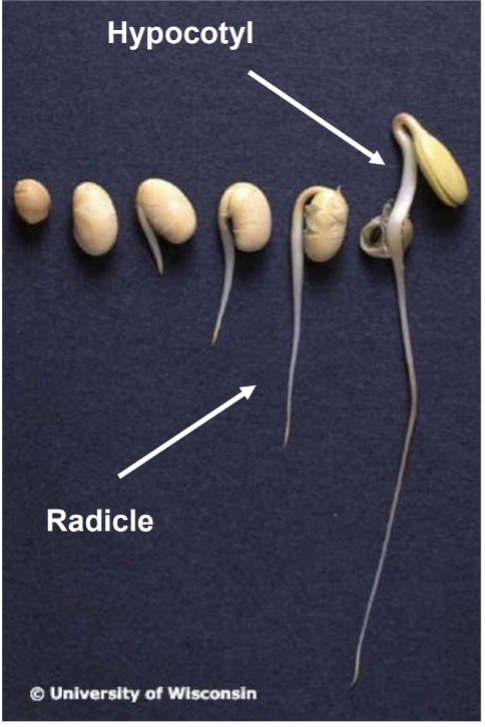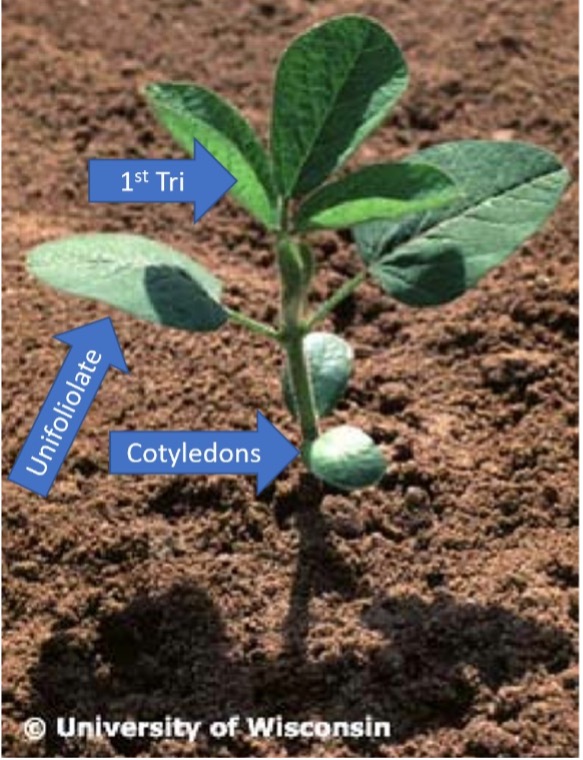ILSOYADVISOR POST
Three Considerations When Evaluating Early Stands
The U. S. Department of Agriculture National Agricultural Statistics Service (USDA NASS) released its latest Crop Progress and Conditions report on May 3, 2021, reporting that soybean planting progress in Illinois is ahead of its five-year average. This doesn’t come as much surprise since many progressive producers have been planting more soybeans earlier than the previous 10 years. With so many soybean fields planted, it’s important to get out and evaluate fields on quality of stand, but to also better understand how a soybean plant grows and develops. Soybean and corn plants are smart, in the fact that when they need something, they will let you know. In most cases, they show their needs through a discolored leaf or stunted plant parts. In fact, a field is pretty smart by these standards, and if there’s a problem area it will not allow soybeans to grow, which result in large areas with dead spots or stunted growth. If you’re seeing any of these issues, now’s the time to start investigating the cause of the problem, so it can be corrected for the current crop or for future crops.
As you’re out doing early stand evaluation, it is important to understand what to look for. Below are some items to keep in mind when looking at a soybean field. It’s important to remember that soybean or corn plants don’t work off our calendar days – they work off of a different work schedule. So first and foremost, stop staying “well they have been in the ground for ‘x days’, and nothing has happened.” These plants work off of accumulated energy and based off the current environment, it may take longer to make progress and recover from injury.
1. It’s important to understand how a soybean plant grows and develops so that when you’re evaluating a stand or a given plant, you know what’s going on and what to expect. 
-
The image on the right shows the progression of a soybean seed from planting to almost emerged. As you can see, the soybean seed will swell after absorbing water from the soil.
-
Like a corn seed, the radical will be the first primary growth that emerges from the seed and will continue to elongate.
-
The hypocotyl and the hypocotyl arc will expand from between the seeds and the radical. It is the physical arc that will pull the former seeds, now cotyledons, out of the soil.
-
When evaluating a stand, understand where your beans are in relationship to these stages.
2. Once the soybean has emerged from the soil, the growing point is officially above the soil surface and the soybean plant becomes more vulnerable to injury and death. Until the cotyledons fully open, the growing point is still somewhat protected from the environment. Recent frosting temperatures and hail events caused damage to many soybean fields; however, the cotyledons were able to protect the growing points.
-
In some microenvironments, hail removed the cotyledons and the growing point was not impacted. However, there were some plants where the hail damage clipped off the cotyledon and the growing point it was prospecting. In situations like this, one needs to look past the green plant parts randomly scattered through the soybean row and look very closely to see if the growing point tissues are safe. In many cases, the damage “looks” worse than it really is. Cotyledons simply act as food storage until the plant can get roots established and leaves can grow and actively partake in photosynthesis. If a soybean can get some good growing conditions, it can make a recovery. This is not the time to add any herbicides to a bean plant – allow the plant time to recover.

-
Once the unifoliolate have been established, all the following leaves will be in a cluster of three and are referred to as trifoliate. For every trifoliate that is counted, it represents a node or a growth advancement. So, if you count three trifoliate, the soybean is in the V-3 growth stage. A soybean will stay in a “V-Stage” until the first open flower is discovered on any of the nodes and then it is considered “R-1.”
-
When a soybean plant enters V2-V3, the relationship between the soil bacteria is taking place and nodulation has begun. Many people do not take the time to dig up soybean roots like they will for a corn plant. It is important to monitor nodulation development across fields or areas of fields to make sure there is not an underlying issue. During this time, be sure to evaluate any inoculate enhancement seed treatment trials.
3. It is also important to remember that Mother Nature does nothing with a straight line, so if something doesn’t seem right in a field, but there are obvious lines, then start thinking about any mechanical pass that would match up. In some cases, it may even be an application that was done last year.
As always, Illinois has a great network of talented CCAs that are ready, willing and able to help support agronomic investigation. Most of us enjoy talking about how a soybean or corn plant grows, and welcome conversation to talk and share our experiences and insight, so please reach out.





Comments
Add new comment